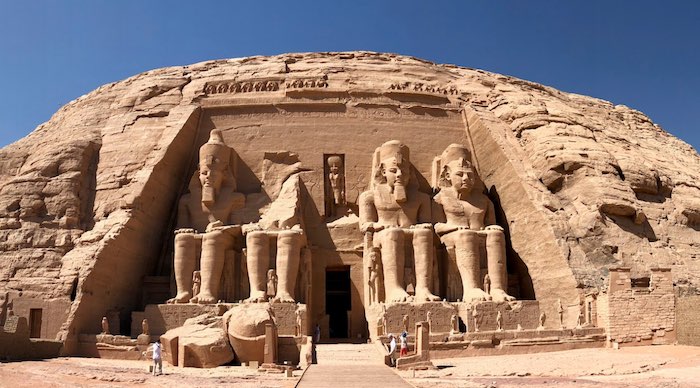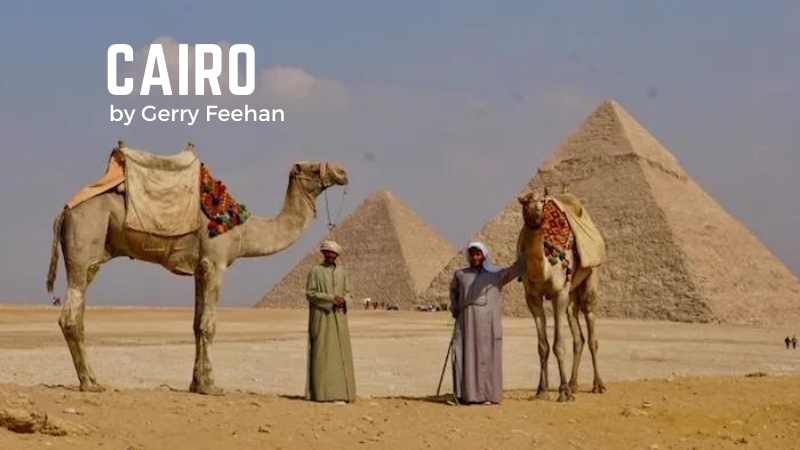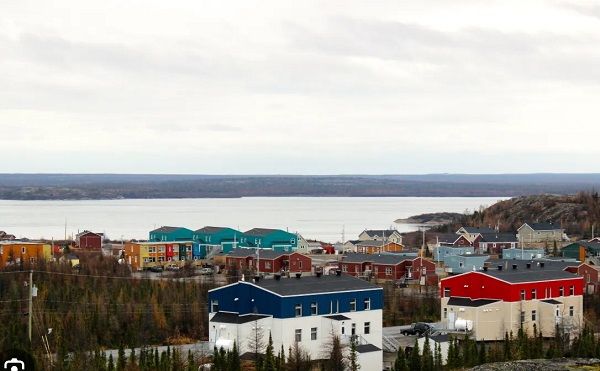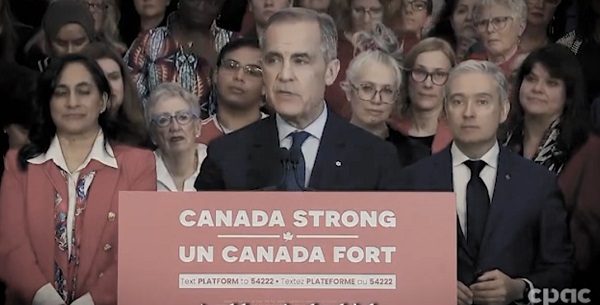Gerry Feehan
Furnace Creek, Stovepipe Wells – even the names sound hot

Death Valley, California. Hotter than Hades by Gerry Feehan
Sans reservation, we arrived at Furnace Creek Campground, 268 feet below sea level. The park ranger informed us unequivocally that the campground was FULL. ‘You’ll have to turn around.’ Feigning a U-turn, I drove in – and immediately found a vacant, primo spot. I sauntered back to the entrance booth and slapped down my 22 bucks.
The light you are seeing left that galaxy over 2,000,000 years ago.’ At this revelation, one family became visibly agitated – and abruptly left the group. As they departed I heard the matriarch exclaim, ‘2,000,000 years. Hasn’t he read the Bible?’

‘Gee, you were lucky,’ the ranger said. ‘Yup, lucky,’ said I. Coincidentally, precisely the same thing had occurred the night before at Stovepipe Wells campground, 30 miles up the road. And, ironically, it was the same lady whose instructions I had disregarded. Fortunately, I am a rather nondescript fellow and she didn’t thwart my advance. I wandered back to our site and set up the BBQ, although I probably could have fried the chicken directly on the searing pavement.
Late, after dinner, as the desert air began to cool, we heard a chewing noise outside the RV. Thinking it might deter intruding varmints, Florence instructed me to pee around the perimeter of the motorhome. A job I was up for. In the morning all was clear. No chewed hoses, flat tires or leaking parts. Feeling secure, we packed lunch and embarked on a stunning, strenuous hike to the summit of Wildrose Peak, 10,000 feet above the salty Death Valley floor. Late in the afternoon we returned, exhausted, to a camper full of… mouse turds.
Turns out our nocturnal intruder was not an external varmint, but one living amongst us. Before bedding down for the night, I set a trap under the sink. After midnight a loud ‘snap’ sounded. One dead mouse. I stepped out into the moonlight and discarded the stiffening carcass. And, my bladder being full, I gave the exterior one last precautionary piss.
The next night we attended an astronomy program outside the Furnace Creek visitor’s center. The topic was the speed of light. ‘For instance,’ the speaker explained, ‘it takes about 8 minutes for light to reach us from the sun. The nearest star is a couple of light years away. Our galaxy is over 100,000 light years across. And that,’ he said, pointing to a small fuzzy patch in the dark sky, ‘is Andromeda. The light you are seeing left that galaxy over 2,000,000 years ago.’ At this revelation, one family became visibly agitated – and abruptly left the group. As they departed I heard the matriarch exclaim, ‘2,000,000 years. Hasn’t he read the Bible?’

After the talk we stayed behind and shared our binoculars with a curious young couple from India. I pointed out some constellations as we chatted. He was a cardiologist, finishing his internship in Pittsburgh. The Indian government had funded a large portion of his education. I asked him if he intended to return to India after completion of his studies – or whether he might remain in the US to mine the riches of America’s fecund medical system.
‘Ah, this is the difficulty,’ he said. ‘Were I to stay, I shall certainly become rather wealthy. But if I return home, I can help a great many people. But there are also some drawbacks. In India the equipment is quite inferior. Also, oftentimes when a doctor operates and the outcome is poor, or perhaps the patient does not survive, the angry family beats the surgeon mercilessly.’ Then, looking up at the magnificent Milky Way and its billion myriad of stars shining onto a California desert, he said, ‘I shall have to ponder this.’
After my rendition of Peaceful Easy Feeling, Nathaniel stood up, stepped behind an enormous eroding rock, and began to weep. After a few minutes, he re-joined us at the fire and approached me for a thankful hug. ‘Sorry, man, but that was so emotional. I haven’t cried like that in forever.’
Out of the dark, a shaggy middle-aged American couple emerged. They introduced themselves as Chuck and Moonbeam. They had just completed their daily sun salutation. Chuck excitedly regaled us with his notion of the universe. ‘I’m an earth, moon, sun type of guy. But Moonbeam, she’s more outer planetary.’ I thought this description odd, given his wife’s moniker, but decided not to quibble over such minor galactic details.
‘Did you know the earth’s magnetic poles are reversing today?’ Moonbeam asked. I tried to explain that any wobble in the earth’s axis would take thousands of years and it would be difficult to note a reverse in polarity, even in a thousand lifetimes. Undeterred, she revealed excitedly, ‘Just this morning my daughter called to say she too felt the vibe.’
We returned to camp. I took out my ukulele. A 30-something fellow scooted by on his long board in the darkness. When he heard me playing, ‘Andrew’ stopped and asked us to join his group at their fire. We acquiesced. Andrew’s friend Nathaniel sat perched on a cahon, beating a deep primeval rhythm to the desert sky. Their female campmates, clad hippie-style in ponchos, danced and twirled, silhouetted by the flickering mesquite blaze.
 I struck up a few tunes. After my rendition of Peaceful Easy Feeling, Nathaniel stood up, stepped behind an enormous eroding rock, and began to weep. After a few minutes, he re-joined us at the fire and approached me for a thankful hug. ‘Sorry, man, but that was so emotional. I haven’t cried like that in forever.’
I struck up a few tunes. After my rendition of Peaceful Easy Feeling, Nathaniel stood up, stepped behind an enormous eroding rock, and began to weep. After a few minutes, he re-joined us at the fire and approached me for a thankful hug. ‘Sorry, man, but that was so emotional. I haven’t cried like that in forever.’
When the evening ended, they all bid us adieu with hands clasped, a bow and a ‘blessings upon you.’ Andrew added, ‘May you have vivid, happy dreams all the night.’ Then we all enjoyed one last hug.
I stumbled back to the trailer, guzzled a beer, and promptly passed out.
None of this is bullshit.
Gerry
We hope you enjoyed Death Valley, California – Hotter than Hades.

Thank you to these great local sponsors who make these stories possible!
Click below to read about some of Gerry’s other great travel adventures.
Gerry Feehan
Abu Simbel

Abu Simbel is a marvel of ancient and modern engineering
I love looking out the window of an airplane at the earth far below, seeing where coast meets water or observing the eroded remains of some ancient formation in the changing light. Alas, the grimy desert sand hadn’t been cleaned from the windows of our EgyptAir jet, so we couldn’t see a thing as we flew over Lake Nasser en route to Abu Simbel. I was hopeful that this lack of attention to detail would not extend to other minor maintenance items, such as ensuring the cabin was pressurized or the fuel tank full.
We had just spent a week on a dahabiya sailboat cruising the Nile River, and after disembarking at Aswan, were headed further south to see one of Egypt’s great
monuments. There are a couple of ways to get to Abu Simbel from Aswan. You can ride a bus for 4 hours through the scorched Sahara Desert, or you can take a plane for the short 45-minute flight.
Opaque windows notwithstanding, I was glad we had chosen travel by air. Abu Simbel is spectacular, but there’s really not much to see except the monument itself and a small adjacent museum. So most tourists, us included, make the return trip in a day. And fortunately we had Sayed Mansour, an Egyptologist, on board. Sayed was there to explain all and clear our pained expressions.
Although it was early November, the intense Nubian sun was almost directly overhead, so Sayed led us to a quiet, shady spot where he began our introduction to
Egyptian history. Abu Simbel is a marvel of engineering — both modern and ancient. The temples were constructed during the reign of Ramses II. Carved from solid rock in a sandstone cliff overlooking the mighty river, these massive twin temples stood sentinel at a menacing bend in the Nile — and served as an intimidating obstacle to would-be invaders — for over 3000 years. But eventually Abu Simbel fell into disuse and succumbed to the inevitable, unrelenting Sahara. The site was nearly swallowed by sand when it was “rediscovered” by European adventurers in the early 19 th century. After years of excavation and restoration, the monuments resumed their original glory.
Then, in the 1960’s, Egyptian president Abdel Nasser decided to construct a new “High Dam” at Aswan. Doing so would create the largest man-made lake in the
world, 5250 sq km of backed-up Nile River. This ambitious project would bring economic benefit to parched Egypt, control the unpredictable annual Nile flood and also supply hydroelectric power to a poor, under-developed country. With the dam, the lights would go on in most Egyptian villages for the first time. But there were also a couple of drawbacks, which were conveniently swept under the water carpet by the government. The new reservoir would displace the local Nubian population whose forbearers had farmed the fertile banks of the Nile River for millennia. And many of Egypt’s greatest monuments and tombs would be forever submerged beneath the deep new basin — Abu Simbel included. But the government proceeded with the dam, monuments be damned.
Only after the water began to rise did an international team of archaeologists, scientists — and an army of labourers — begin the process of preserving these
colossal wonders. In an urgent race against the rising tide, the temples of Abu Simbel were surgically sliced into gigantic pieces, transported up the bank to safety and reassembled. The process was remarkable, a feat of engineering genius. And today the twin edifices, honouring Ramses and his wife Nefertari remain, gigantic, imperious and intact. But instead of overlooking a daunting corner of the Nile, this UNESCO World Heritage site now stands guard over a vast shimmering lake.
Sayed led us into the courtyard from our shady refuge and pointed to the four giant Colossi that decorate the exterior façade of the main temple. These statues of
Ramses were sculpted directly from Nile bedrock and sat stonily observing the river for 33 centuries. It was brutally hot under the direct sun. I was grateful for the new hat I had just acquired from a gullible street merchant. Poor fellow didn’t know what hit him. He started out demanding $40, but after a prolonged and brilliant negotiating session, I closed the deal for a trifling $36. It was difficult to hold back a grin as I sauntered away sporting my new fedora — although the thing did fall apart a couple of days later.
Sayed walked us toward the sacred heart of the shrine and lowered his voice. Like all Egyptians, Sayed’s native tongue is Arabic. But, oddly, his otherwise perfect English betrayed a slight cockney accent. (Sayed later disclosed that he had spent a couple of years working in an East London parts factory.) He showed us how the great hypostyle hall of the temple’s interior is supported by eight enormous pillars honouring Osiris, god of the underworld.

Exploring the inner temple

Nefertari
Sayed then left us to our devices. There were no other tourists. We had this incredible place to ourselves. In the dim light, we scampered amongst the sculptures
and sarcophagi, wandering, hiding and giggling as we explored the interior and its side chambers. At the far end lay the “the holiest of holies” a room whose walls were adorned with ornate carvings honouring the great Pharaoh’s victories — and offering tribute to the gods that made Ramses’ triumphs possible.
Exterior photographs of Abu Simbel are permitted, but pictures from within the sanctuary are verboten — a rule strictly enforced by the vigilant temple guardians — unless you offer a little baksheesh… in which case you can snap away to your heart’s content. Palms suitably greased, the caretakers are happy to pose with you in front of a hidden hieroglyph or a forbidden frieze, notwithstanding the stern glare of Ramses looking down from above.

A little baksheesh is key to holding the key
After our brief few hours at Abu Simbel, we hopped back on the plane. The panes weren’t any clearer but, acknowledging that there really wasn’t much to see in the Sahara — and that dirty airplane windows are not really a bona fide safety concern — I took time on the short flight to relax and bone up on Ramses the Great, whose mummified body awaited us at the Egyptian Museum in Cairo.
Exodus Travel skilfully handled every detail of our Egypt adventure: www.exodustravels.com/
Gerry Feehan is an award-winning travel writer and photographer. He lives in Kimberley, BC.

Thanks to Kennedy Wealth Management for sponsoring this series. Click on the ads and learn more about this long-term local business.
Gerry Feehan
Cairo – Al-Qahirah

The Pyramids of Giza
The first thing one notices upon arrival in Egypt is the intense level of security. I was screened once, scanned twice and patted down thrice between the time we landed at the airport and when we finally stepped out into the muggy Cairo evening. At our hotel the scrutiny continued with one last investigation of our luggage in the lobby. Although Egyptian security is abundant in quantity, the quality is questionable. The airport x-ray fellow, examining the egg shaker in my ukulele case, sternly demanded, “This, this, open this.” When I innocently shook the little plastic thing to demonstrate its impermeability he recoiled in horror, but then observed it with fascination and called over his supervisor. Thus began an animated, impromptu percussion session. As for the ukulele, it was confiscated at hotel check-in and imprisoned in the coat check for the duration of our Cairo stay. The reasons proffered for the seizure of this innocuous little instrument ranged from “safety purposes” to “forbidden entertainment”. When, after a very long day, we finally collapsed exhausted into bed, I was shaken — but did not stir.
Al-Qahirah has 20 million inhabitants, all squeezed into a thin green strip along the Nile River. Fading infrastructure and an exponential growth in vehicles have contributed to its well-deserved reputation as one of the world’s most traffic-congested cities. The 20km trip from our hotel in the city center, to the Great Pyramid of Cheops at Giza across the river, took nearly two hours. The driver smiled, “Very good, not rush hour.”
Our entrance fee for the Giza site was prepaid but we elected to fork out the extra Egyptian pounds to gain access to the interior of the Great Pyramid. Despite the up-charge — and the narrow, dark, claustrophobic climb – the reward, standing in Cheop’s eternal resting place, a crypt hidden deep inside the pyramid, was well worth it. We also chose to stay after sunset, dine al fresco in the warm Egyptian evening, and watch the celebrated ‘sound and light’ performance. The show was good. The food was marginal. Our waiter’s name was Fahid. Like many devout Muslim men, he sported a zabiba, or prayer bump, a callus developed on the forehead from years of prostration. Unfortunately throughout the event Fahid hovered over us, attentive to the point of irritation, blocking our view of the spectacle while constantly snapping fingers at his nervous underlings. The ‘son et lumière’ show was a little corny, but it’s pretty cool to see a trio of 4500-year-old pyramids – and the adjoining Great Sphinx — illuminated by 21 st century technology.

The Great Sphinx

Giza at nightThe next night our group of six Canucks attended an Egyptian cooking class. Our ebullient hostess was Anhar, (‘the River’ in Arabic). Encouraged by her contagious enthusiasm, we whipped up a nice tabouli salad, spicy chicken orzo soup and eggplant moussaka. We finished up with homemade baklava. Throughout the evening, Anhar quizzed us about the ingredients, the herbs and spices, their origins and proper method of preparation. Anyone who answered correctly was rewarded with her approving nod and a polite clap. Soon a contest ensued. Incorrect answers resulted in a loud communal ‘bzzzt’ — like the sound ending a hockey game. It’s not polite to blow one’s own horn, but the Feehan contingent acquitted themselves quite nicely. If I still had her email, Anhar could confirm this.
Cairo was not the highlight of our three-week Egyptian holiday, but a visit to the capital is mandatory. First there’s the incredible Pyramids. But as well there’s the Egyptian Museum that houses the world’s largest collection of Pharaonic antiquities including the golden finery of King Tutankhamen and the mummified remains of Ramses the Great. Ramses’ hair is rust coloured and thinning a little, but overall he looks pretty good for a guy entering his 34 th century.

Ramses the Great

Then there’s Khan el-Khalili, the old souk or Islamic bazaar. We strolled its ancient streets and narrow meandering alleyways, continually set upon by indefatigable street hawkers. “La shukraan, no thanks,” we repeated ineffectually a thousand times. The souk’s cafes were jammed. A soccer match was on. The ‘beautiful game’ is huge in Egypt. Men and women sat, eyes glued to the screen, sipping tea and inhaling hubbly bubbly.

The Old Souk Bazaar

Selfies, Souk style
An aside. When traveling in Egypt, be sure to carry some loose change for the hammam (el baño for those of you who’ve been to Mexico). At every hotel, restaurant, museum and temple — even at the humblest rural commode — an attendant vigilantly guards the lavatory. And have small bills for the requisite baksheesh. You’re not getting change.
After our evening in the souk we had an early call. Our guide Sayed Mansour met us at 6am in the hotel lobby. “Yella, yella. Hurry, let’s go,” he said. “Ana mish bahasir – I’m not joking.” “Afwan,” we said. “No problem,” and jumped into the van. As we pulled away from the curb Sayed began the day’s tutorial, reciting a poem by Percy Blythe Shelly:
I met a traveller from an antique land,
Who said—“Two vast and trunkless legs of stone
Stand in the desert. . . . My name is Ozymandias, King of Kings;
Look on my Works, ye Mighty, and despair!”
And we were off, through the desert, to Alexandria. Founded by Alexander the Great in 332 BC, Egypt’s ancient capital was built on the Nile delta, where the world’s longest river meets the Mediterranean Sea. The day was a bit of a bust. The city was once renowned for its magnificent library and the famed Lighthouse of Alexandria. But the former burnt down shortly after Christ was born and the latter — one of the original seven wonders of the ancient world – toppled into the sea a thousand years ago. Absent some interesting architecture, a nice view of the sea from the Citadel — and Sayed’s entertaining commentary — Alexandria wasn’t really worth the long day trip. Besides, we needed to get back to Cairo and pack our swimwear. Sharm el Sheikh and the warm waters of the Red Sea were next up on the Egyptian agenda.

Gerry with some Egyptian admirers
Exodus Travel skilfully handled every detail of our trip: www.exodustravels.com And, if you’re thinking of visiting Egypt, I can suggest a nice itinerary. No sense reinventing the pyramid: [email protected]
Gerry Feehan is an award-winning travel writer and photographer. He lives in Kimberley, BC.

Thanks to Kennedy Wealth Management for sponsoring this series. Click on the ads and learn more about this long-term local business.
-

 Alberta2 days ago
Alberta2 days agoProvince to expand services provided by Alberta Sheriffs: New policing option for municipalities
-

 Bruce Dowbiggin2 days ago
Bruce Dowbiggin2 days agoIs HNIC Ready For The Winnipeg Jets To Be Canada’s Heroes?
-

 2025 Federal Election2 days ago
2025 Federal Election2 days agoCSIS Warned Beijing Would Brand Conservatives as Trumpian. Now Carney’s Campaign Is Doing It.
-

 Alberta2 days ago
Alberta2 days agoMade in Alberta! Province makes it easier to support local products with Buy Local program
-

 2025 Federal Election2 days ago
2025 Federal Election2 days agoNo Matter The Winner – My Canada Is Gone
-

 Health2 days ago
Health2 days agoHorrific and Deadly Effects of Antidepressants
-

 2025 Federal Election2 days ago
2025 Federal Election2 days agoCampaign 2025 : The Liberal Costed Platform – Taxpayer Funded Fiction
-

 2025 Federal Election2 days ago
2025 Federal Election2 days agoA Perfect Storm of Corruption, Foreign Interference, and National Security Failures







